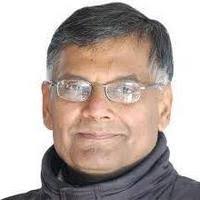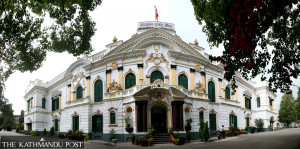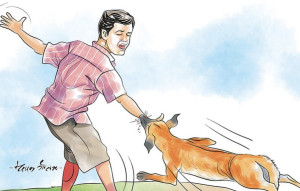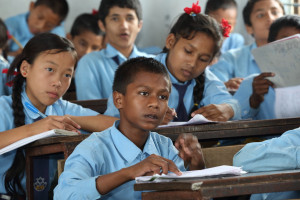Columns
A downturn in the ‘Windustry’ sector
The long run of easy money for Windustry seems to be ending with the suspension of USAID funding.
CK Lal
In an apocryphal story, Indian economist and Marxist scholar Ashok Mitra (1928–2018) narrates the career trajectory of a spoiled brat of one of the anti-communist caudillos of the 1950s. Once some of these military princelings from Paraguay, Nicaragua, the Dominican Republic, or Venezuela graduated from nondescript colleges in the United States, they would approach the World Bank or the International Monetary Fund in Washington, DC for a sinecure to stay away from political uncertainties in their home countries.
The Bretton Woods sisters had little use for the entitled offsprings of the ruling juntas of banana republics. The Bank or Fund officials would take up the matter with the State Department, who in turn would speak to someone at the Pentagon, and thereafter these scions of military and civil elite of US-backed dictatorships would fly back home to take charge at vital economic institutions such as the finance ministry, the central bank or the planning authority. A few promising ones would later be absorbed into the UN system once their utility on the home turf was over.
Similar things were taking place in most client countries of the US. In Nepal, Vietnam hawk Ellsworth Bunker first operated from New Delhi in the late-1950s and then continued to do so through his partner, Ambassador Carol Laise Bunker, from the mid-1960s up until the early 1970s. The power couple of the Cold War identified, groomed and positioned graduates of American universities in key positions of Panchayat rule. Ambassador Bunker’s infamous assessment— “We have a democratic tradition dating back hundreds of years, and they have a hierarchical tradition. They should choose their own kind of government”—was music to the ears of loyalists of the Shah regime.
The storyline remained unchanged, but the props changed after the implosion of the Soviet Union began in the late-1980s. The heirs of prominent civil, military and political families were asked to return home after graduation and take up entrepreneurial roles at non-government organisations (NGOs) or not-for-profit organisations (NPOs) that had begun to proliferate in countries with an authoritarian past. Some of them would be advised to stage performative activism in human rights or movements of the marginalised to establish their credibility so that their leadership would look normal and become unassailable. Specially, donor-dependent initiatives such as Donor Organised NGOs (DONGOs), International NGOs (INGOs) and Big International NGOs (BINGOs) turned out to be employers of choice for the progenies of local elite.
The transformation of a vocation or calling into a lucrative occupation gained momentum once bilateral donors and multilateral lenders started to recognise the Civil Society as the third pillar of governance. Once put on a par with the State and the Market, social enterprises emerged as important players of political economy. Western donors saw them as a line of defence against the rise of leftwing extremism and religious radicalism in poor countries. The Pakistani-British writer Tariq Ali calls such enterprises Western Governmental Organisations (WGOs) as they “buy up lots and lots of” political and social activists. The lapsed Marxist-Leninists of the UML variety and remnants of the authoritarian Shah regime (1960-90) continue to dominate the NGO sector to this day.
Gathering cloud
Any data in Nepal is suspect, but it is said that the number of NGOs grew tenfold from about 200 in 1990 to over 2000 in 1995 and has since surpassed 54,000 by 2025. The country of less than 3 million population, almost one-third of it studying or working abroad, boasts more than 100,000 formal and informal social enterprises—which comes out to be one organisation working for every 200 people or so.
By the Rhododendron Revolution of 2006, the non-profit sector had become a significant contributor to the national economy. It was the employer of choice for the urban bourgeoisie of the White Shirt variety. The sector engaged an army of field researchers, consultants, experts and advisers to assist conflict resolution and peace-making efforts after the decade old (1996-2006) armed conflict. The support services flourished as hotels, travel agencies and car hire companies profited from a boom in the MICE (Meetings, Incentives, Conferences, and Events) tourism.
Office rents in upmarket localities went up. In the neighbourhood the UN System at Pulchowk, the conversion of a relatively quiet Jhamsikhel and Dhobighat areas into the happening streets of Jhamel—patterned after touristy Thamel—was complete with newer hotels, fine-dining restaurants, upscale bars, popular cafes, pricey spas and even a few fancy boutiques. Due to higher pay scales and tax deduction at source, the NGO industry—hereafter the Windustry, a neologism to denote its dependence on Western donors and to differentiate it from other service industries—emerged as a significant contributor to national revenue.
Nothing great lasts forever and the long run of easy money for the Windustry seems to be coming to an end with the suspension of USAID funding. Even though the USAID spent only about 0.49 percent of the federal budget, which works out to about $105 per US citizen per year, it was a considerable source of funding for humanitarian response during crises, vaccination, healthcare, education and disaster preparedness in the developing countries. Close on its heels, the UK has announced that it would be cutting its foreign aid budget from roughly 0.5 percent of gross national income to 0.3 percent to allocate more funds to defence.
Much of the foreign aid is channelled through the UN system, development agencies and contractual service providers of donor countries that work with the recipient government. It is estimated that less than 15 percent of foreign aid was directed towards NGOs in Nepal. But it kept the wheels churning with the Windustry establishing itself as a career option for Nepali youths unable or unwilling to go abroad in search of employment.
Incipient hailstorm
Unlike many of his peers in the Windustry, Ajay Das has come up from the bundocks through sheer hard work. Through the journey of being a media personality to becoming an international expert, he may not have gathered much moss but had got so much shine that he was given the responsibility of implementing the Civil Society and Media Programme (CSM) of the Asia Foundation as its Programme Director. He seems to be in-between-jobs and was in Jumla when I contacted him about the immediate impact of the suspension of USAID funding.
Unless they are the ones holding the reins, the socio-political elite of Kathmandu detests any activity aimed at empowering the marginalised of the countryside. Fully funded by USAID, the CSM was working with 56 partner NGOs in Lumbini and Madhesh. Altogether, the programme employed 30 people directly and about 250 through partner organisations. Auxiliary and support services had created additional jobs. Overnight, it has all disappeared in thin air with President Donald Trump’s Department of Government Efficiency (DOGE) eating up the promised grant.
With development assistance disappearing, the US strategists of Cold War II may take the route of covert funding—grants of surreptitious foundations, dubious academics and shady researchers or even direct distribution of cash—to sustain their assets and maintain presence in the marketplace of peddling influence in Kathmandu.




 9.12°C Kathmandu
9.12°C Kathmandu













%20(1).jpg&w=300&height=200)

